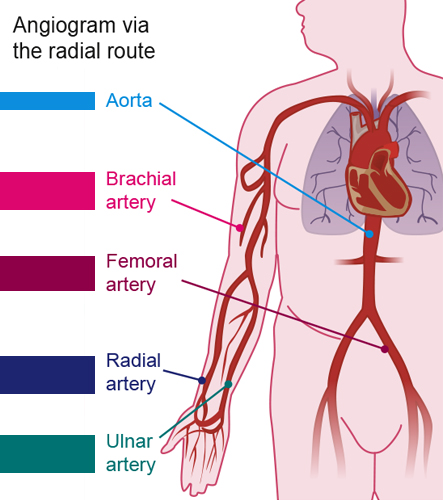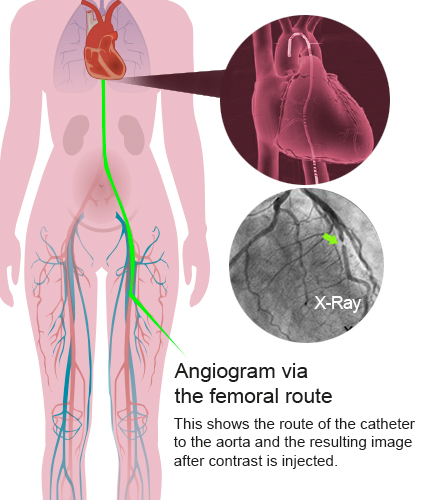

Coronary angiography is a direct method of imaging the coronary arteries. This invasive procedure involves introducing fine cardiac catheters (approximately 2mm in diameter) inserted over guidewires (Seldinger technique) into the radial (or occasionally femoral) artery and advanced to the aorta. The catheters are designed to select the left and right coronary arteries. X-ray contrast medium (usually Iodine based) is then injected and radiographic images taken of the coronary arteries to visualise areas of coronary stenosis or occlusion.
This can determine the need for and best mode of revascularisation in patients with coronary artery disease. See Acute Coronary Syndrome: Case 1 Hamish for an animation of a coronary angiogram performed via the right radial approach and a Video of a coronary angiogram showing 3 vessel disease.
Risk of MI, Stroke or Death
- Risk is estimated at < 1 in 1000 (Ref-British Heart Foundation 2014) However the level of risk for the individual depends on their overall health, age and heart condition.
- The Clinician will not recommend the test unless it is believed that the benefits outweigh the risk, however he/she must discuss this fully and openly with the patient.
- The patient must give written informed consent prior to the procedure.
Patient information before the procedure:
- Patients should be advised they may feel a bit of pushing and pulling as the catheter is manoeuvred into place and a warm flush feeling as the dye is injected
- They will be given local anaesthetic at the entry site (wrist or groin)
- They can be given some light sedation if anxious about the procedure
Safety Issues & Complications
Coronary angiography is relatively safe however it is an invasive procedure and there are some risks of complications:
- Insertion of the guide wire can cause arterial trauma
- Air bubbles in the cardiac catheter can cause air embolus
- Haematoma can occur at the arterial access site (more common when the femoral artery is used)
- Embolisation of thrombus or atheroma is possible
- Arrhythmias (atrial or ventricular) are possible during the procedure
- A vaso-vagal response may occur during the sheath removal from the femoal atery
- Coronary occlusion
- Dye sensitivity can cause nausea, hypotension or urticarial N.B It is important to check first if patients have any allergies – to previous dye, iodine or shellfish (contain iodine)
- The contrast can be nephrotoxic therefore there is a risk of renal failure – increased risk if the patient already had renal impairment
- Having a coronary angiogram involves exposure to some radiation, which is more than a CXR but less than an MPS or CT coronary angiogram.
Please enable JavaScript in your browser to see this interactive content.
Page last reviewed: 30 Jul 2020


